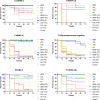In vitro and in vivo Effect of Antimicrobial Agent Combinations Against Carbapenem-Resistant Klebsiella pneumoniae with Different Resistance Mechanisms in China
- PMID: 33707959
- PMCID: PMC7943327
- DOI: 10.2147/IDR.S292431
In vitro and in vivo Effect of Antimicrobial Agent Combinations Against Carbapenem-Resistant Klebsiella pneumoniae with Different Resistance Mechanisms in China
Abstract
Objective: This study aimed to evaluate the in vitro and in vivo effects of different combinations of antimicrobial agents against carbapenemase-producing and non-producing Klebsiella pneumoniae from China.
Methods: A checkerboard assay of meropenem (MEM), amikacin (AK), tigecycline (TGC), colistin (COL) and their combinations was carried out against 58 clinical carbapenem-resistant K. pneumoniae (CRKp) isolates, including 11 carbapenemase-non-producing K. pneumoniae isolates and 21 isolates producing KPC-2 enzyme, 11 NDM-1, 13 IMP, one VIM-1 and one OXA-48. The checkerboard assay was analyzed by the fractional inhibitory concentration index (FICI). A time-kill assay and Galleria mellonella infection model were conducted to evaluate the in vitro and in vivo effects of the four drugs alone and in combination.
Results: In the checkerboard assay, TGC+AK and MEM+AK combinations showed the highest synergistic effect against KPC-2 and NDM-1 carbapenemase-producing isolates, with synergy+partial synergy (defined as FICI <1) rates of 76.2% and 71.4% against KPC-2 producers, and 54.5% and 81.8% against NDM-1 producers. TGC+AK and MEM+COL combinations showed the highest rate of synergistic effect against IMP-producing isolates. Against carbapenemase-non-producing isolates, TGC+COL and TGC+AK combinations showed the highest rate of synergy effect (63.6% and 54.5%). MEM+AK showed a synergistic effect against one VIM-1 producer (FICI=0.31) and an additivite effect (FICI=1) against one OXA-48 producer. In the time-kill assay, COL+AK, COL+TGC, COL+MEM and AK+TGC showed good synergistic effects against the KPC-2-producing isolate D16. COL+MEM and COL+TGC combinations showed good effects against the NDM-1-producing isolate L13 and IMP-4-producing isolate L34. Against the carbapenemase-non-producing isolate Y105, MEM+TGC and COL+AK showed high synergistic effects, with log10CFU/mL decreases of 6.2 and 5.5 compared to the most active single drug. In the G. mellonella survival assay, MEM-based combinations had relatively high survival rates, especially when combined with colistin, against KPC-2 producers (90% survival rate) and with amikacin against metallo-beta-lactamase producers (95-100% survival rate).
Conclusion: Our study suggests that different antimicrobial agent combinations should be considered against CRKp infections with different resistance mechanisms.
Keywords: CRKP; Galleria mellonella infection model; antimicrobial agent combinations; carbapenem-resistant Klebsiella pneumoniae; resistance mechanisms; time–kill curve assay.
© 2021 Liu et al.
Conflict of interest statement
The authors report no conflicts of interest in this work. The funders had no role in the study design, collection, and analysis of data, interpretation of results, or preparation of the manuscript.
Figures



Similar articles
-
Effect of ceftazidime-avibactam combined with different antimicrobials against carbapenem-resistant Klebsiella pneumoniae.Microbiol Spectr. 2024 Jun 4;12(6):e0010724. doi: 10.1128/spectrum.00107-24. Epub 2024 May 7. Microbiol Spectr. 2024. PMID: 38712934 Free PMC article.
-
[Evaluation of In Vitro Efficacy of Ceftazidime-Avibactam, Meropenem, and Colistin Single and Binary Combinations Against Carbapenem Resistant Klebsiella pneumoniae Strains Isolated from Various Clinical Specimens].Mikrobiyol Bul. 2022 Apr;56(2):230-250. doi: 10.5578/mb.20229804. Mikrobiyol Bul. 2022. PMID: 35477227 Turkish.
-
Tigecycline in combination with other antibiotics against clinical isolates of carbapenem-resistant Klebsiella pneumoniae in vitro.Ann Palliat Med. 2019 Nov;8(5):622-631. doi: 10.21037/apm.2019.09.11. Epub 2019 Oct 23. Ann Palliat Med. 2019. PMID: 31735038
-
Microbiology of Meropenem-Vaborbactam: A Novel Carbapenem Beta-Lactamase Inhibitor Combination for Carbapenem-Resistant Enterobacterales Infections.Infect Dis Ther. 2020 Dec;9(4):757-767. doi: 10.1007/s40121-020-00350-1. Epub 2020 Oct 5. Infect Dis Ther. 2020. PMID: 33017041 Free PMC article. Review.
-
The Epidemiology, Evolution, and Treatment of KPC-Producing Organisms.Curr Infect Dis Rep. 2018 May 5;20(6):13. doi: 10.1007/s11908-018-0617-x. Curr Infect Dis Rep. 2018. PMID: 29730830 Review.
Cited by
-
Effect of ceftazidime-avibactam combined with different antimicrobials against carbapenem-resistant Klebsiella pneumoniae.Microbiol Spectr. 2024 Jun 4;12(6):e0010724. doi: 10.1128/spectrum.00107-24. Epub 2024 May 7. Microbiol Spectr. 2024. PMID: 38712934 Free PMC article.
-
Combined therapeutic option for NDM-producing Serratia Marcescens - an in vitro study from clinical samples.Braz J Infect Dis. 2025 Jan-Feb;29(1):104481. doi: 10.1016/j.bjid.2024.104481. Epub 2024 Nov 26. Braz J Infect Dis. 2025. PMID: 39602851 Free PMC article.
-
Resistance Phenotype and Molecular Epidemiology of Carbapenem-Resistant Klebsiella pneumoniae Isolated from Nanjing Children's Hospital in Jiangsu Province, China.Infect Drug Resist. 2022 Sep 14;15:5435-5447. doi: 10.2147/IDR.S377068. eCollection 2022. Infect Drug Resist. 2022. PMID: 36131812 Free PMC article.
-
In vitro synergy screens of FDA-approved drugs reveal novel zidovudine- and azithromycin-based combinations with last-line antibiotics against Klebsiella pneumoniae.Sci Rep. 2023 Sep 2;13(1):14429. doi: 10.1038/s41598-023-39647-9. Sci Rep. 2023. PMID: 37660210 Free PMC article.
-
Effectiveness of antimicrobial agent combinations against carbapenem-producing Klebsiella pneumoniae with KPC variants in China.Front Microbiol. 2025 Jan 22;15:1519319. doi: 10.3389/fmicb.2024.1519319. eCollection 2024. Front Microbiol. 2025. PMID: 39911707 Free PMC article.
References
-
- Centres for Disease Control and Prevention (US). Antibiotic Resistance Threats in the United States. Centers for Disease Control and Prevention; 2013.
LinkOut - more resources
Full Text Sources
Other Literature Sources
Miscellaneous

